12 Types of Mops to Help You Clean More Efficiently
Author: Anne Cowart | Editor: Omar Alonso
Review & Research: Jen Worst & Chris Miller
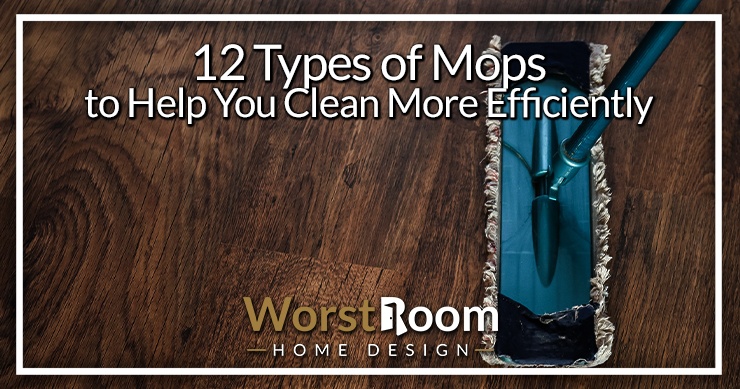
Cleaning a floor to perfection cant be intimidating if you don't have the right cleaning tool in your hands. As surface wipers, any of the types of mops are an ideal solution for the majority of people. Things are not as easy as it seems, you simply cannot go to the market and get any random mop.
There are many different variations in terms of style, shape, and form — and each has its unique use. We are here to discuss the different types of mops to ensure you know about the contrasting features and where to utilize them.
12 Types of Mops
You might have heard about dry mop and wet mop, but do you know there is more to it than you can imagine? There are different categories of mops that can be used in numerous ways.
For a more polished and spotless outcome, it's advised that you dig out the different classes. The latter part is written to give you a clear picture. Keep on reading, and don't forget to check out the types of buckets, too, since you'll need a mop bucket.
Dust Mops
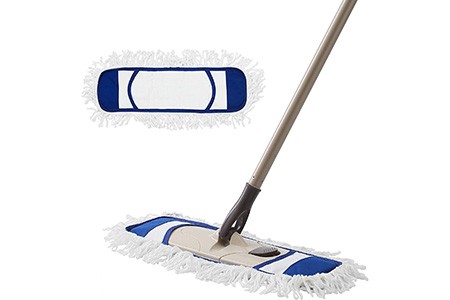
This cleaning gear is particularly made to eliminate dust from the flooring. It is a dry mop that is used after you've cleaned the surface with a wet mop. Dust mops have a longer reach and can be used in tighter spaces to take out dust.
They are made with microfiber, lambswool, and sometimes synthetics, all capable of attracting the topped up dust. As this piece of gear will efface a handful of dust, it is good that you purchase a reusable one which makes it easier to clean and wash before every use.
Dust mops can be very useful in preparing a surface before using a wet mop or simply use to glide an already wiped floor to make it look more pristine.
Sponge Mops
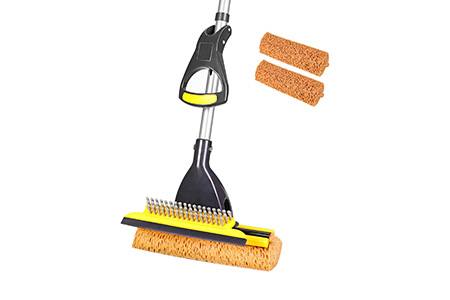
A sponge mop is what the name suggests, it sponges and takes away the excessive dirt. Mostly used on spill stains such as the ones you get from splashed water, knock over soups, juices, and other liquids.
These mop styles have a spongy frontal head that is made to absorb all liquid at will. Some sponge mop types come with a removable head for convenient storage.
Sponge mops tend to catch a lot of bacteria, and therefore, they must be rinsed after every use and placed upright to get rid of the accumulated water.
It is advised that people who have a sponge tool must always look for deterioration and go for replacement in case of any breaks and strong odor.
Flat Mops
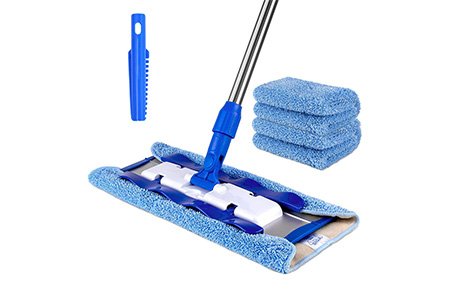
This particular cleaning tool is the most commonly used one in the commercial market. Suited for hard floors and vinyl decks, flat mops can be very useful in cleaning out dirt, stains, and dust. In general flat-head mops are something that attracts the grimes easily because of their design and shape.
Some have detachable types of mop heads that can be a positive for easy storage. The slim jim shape is what makes it reach intricate spots like corners and small nooks. It can be used wet or as a dry scrubber.
Flat types of mops are a viable choice when it comes to regular cleaning chores, but it is not ideal for taking out adamant mucks from the floor or cleaning colossal floorboards where you'd prefer a string mop. You won't need a bucket, but perhaps just a spray bottle with your cleaning solution in it.
Steam Mops
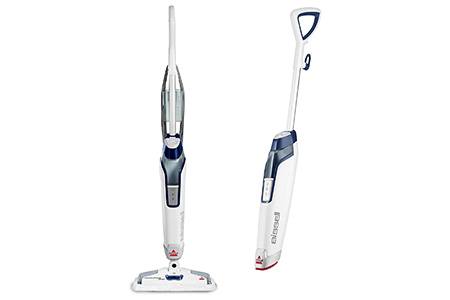
For effectively cleaning and disinfecting floors, there is nothing better than a steam mop. These are electrical appliances and are completely different from orthodox mops. Well, the cleaning part is what's common, apart from that, the use is completely different.
Steam kinds of mops have storage compartments for water and use electricity to heat the liquid. The steam is then flushed out using a trigger controlled by the user.
Steam of water is suitable for eliminating sticky and tough residues from the floor. They can be used on tiled surfaces, cabinets, and other places. But don't use a steam mop on a vinyl floor.
The design is what makes them reach smaller spaces and can also clean large areas. One drawback of this particular variation is that it is a tad bit more expensive than the manual mops.
String Mops
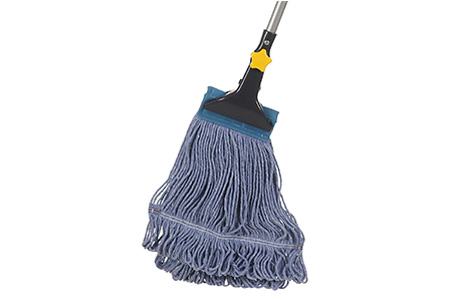
A string mop is likely to be found in every household, if not all, then many. Unlike sponge mops and flat mops, these have cotton strings attached to the front. The cotton material is more absorbent and can take out the trash with ease.
It is a wet mop, meaning you have to use it by soaking it in a bucket and straining the accumulated liquids after every wipe. It does a good job of cleaning floors but on the contrary, it is a bit tricky to maintain. These can be a pain to use or a blessing if you know how to mop properly.
Keep in mind that string mop types do leave some wet patches behind, therefore it's best to use a dust mop or flat mops after the leftover water is dried out if you care. If you use Murphy's Oil Soap, you can leave some of the solution behind if you wring your mop out well as you go.
Strip Mops
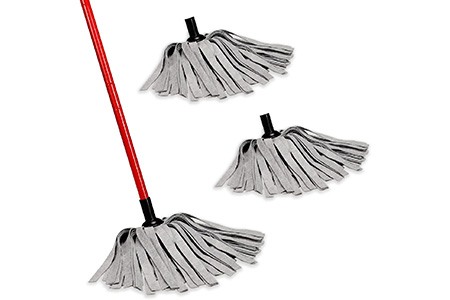
Talking about variation, strip mop styles are very similar to the string mop as they are almost identical, it's just that the strips separate them from the string end. In such tools, you will get a detachable head containing fabric strips that can be washed on a washer after the cleaning task.
Strip mops are ideal for dusting surfaces because the strips work well on surface dust. It can also be used as a wet mop, but that won't be much effective in terms of cleansing if compared to the dust mop or sponge types of mops.
Brush Mops
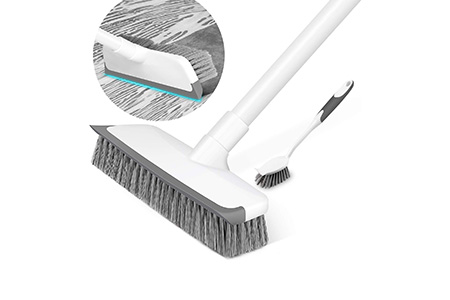
These styles of mops have bristles attached to the head. Yes, bristles are there to give the user more flexibility to clean the dust and dirt from the surface.
This particular kind is like one of the types of brooms that can be used on kitchen floors to take away food remains or spilled drinks. A brush mop might not be as effective as a microfiber or sponge mop, but it is a decent choice for small cleaning tasks.
Spin Mops
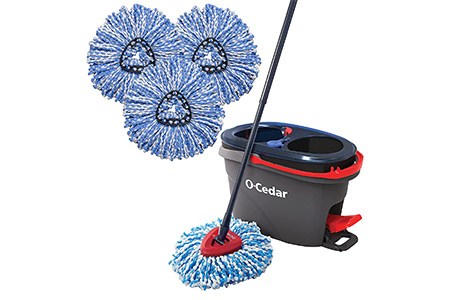
It is simply a string mop with a spinning feature. There is a pulling latch to spin the strings when put inside a bucket to suitably wring out the liquids. The majority of the spin mops have a bucket with a spinner at the bottom.
When the head is placed inside, the front end should spin in a circular motion and fling out the collected water and filth from the attached strings. The user has the upper hand to spin the mop in a circular motion to fight tough stains from the floor.
Automated / Robot Mops
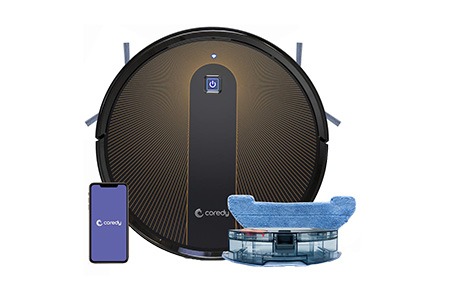
Well, the name says it all. You have a cleaning assistant for wiping your floor. Robot mops are automated devices that are extremely useful for shining and polishing the floor.
This is for people who don't want their hands dirty but rather need a helping hand. Why not get a robot instead of human labor?
These auto devices work on their own, and the cleaning limitations and settings can be adjusted on the stitch panel and can be seen using the LCD screen.
While at work, these devices should move around and mop the floor successfully. These devices have A.I sensors that can sense if the ways are blocked.
Microfiber Mops
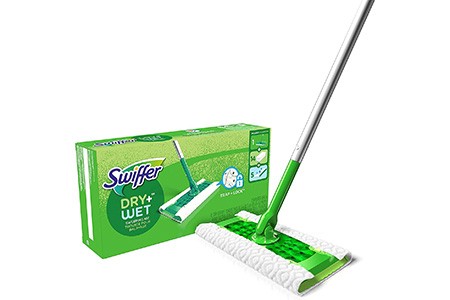
The use of microfiber in cleaning jobs has been on the rise because it has more absorbing power than any other material.
It is even more potent than a sponge device, and the good thing about fiber types of towels is that they are easy to maintain and wash without having to worry about it disintegrating.
Microfiber mops can be used both as a wet mop and dry types of mops. When used as a dry tool it can easily pick off the leftover specks of dust on the floor, and later it can be worked as a wet mop to apply the finishing touch.
Static Mops
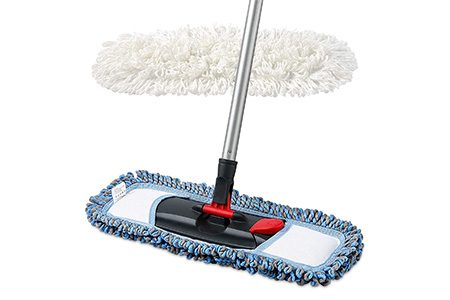
These particular styles of mops are solely used for dry cleaning needs. It is a variation of dust mop with the design of a floor mop.
What separates static mop types is that there are microfiber heads attached to it. For a quick wipe-off, static mops are a decent option. The microfiber end is placed ergonomically to collect dust and debris from the floor.
Disposable Mops
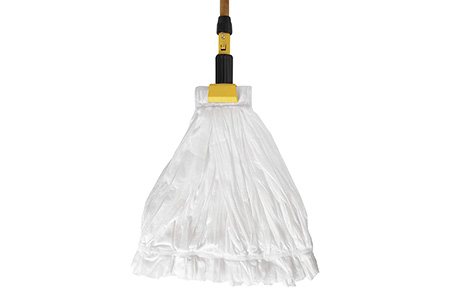
When we say disposable mops, we don't mean the entire handle and head and everything. We're referring to the scrubbing part, which is usually attached to these specific mop head types by velcro or wrapped around it and clipped into place.
Some of these will dispense solution for you through the handle, and others will ask you to carry a squirt bottle with you. But once you're done, you simply pull off the cloth cleaner and throw it away, acting as paper towel alternatives for larger messes or for those that can't get their body on the ground to clean. There are also variations you can wash in your washing machine.
Types of Mops to Clean the Floor Faster & Better
If you have had the time to read this article, you already know about all the different kinds of mops available on the market. Before purchasing mops for cleaning needs, you must realize your workload and the types of floors you are cleaning.
For example, going for a strip mop or string mop to take out spill stains won't suit the task and will further hamper the process. Therefore knowing the distinction and the workability of the different types of mops can work wonders for you.
You'll Also Enjoy:
- 10 Clothes Wringer Alternatives for When There's No Other Options
- 16 Types of Toilet Seats to Provide Perfect Comfort
- 9 Dryer Sheet Alternatives You Can Use Now With Household Goods
- 10 Fabric Softener Alternatives to Keep Your Clothes Fresh
- 9 Humidifier Alternatives to Moisturize Your Dry Air Easily




